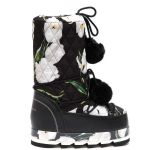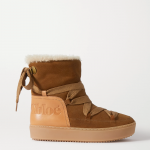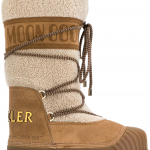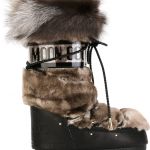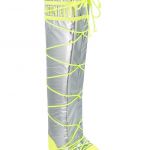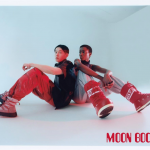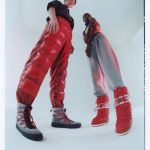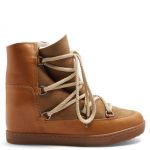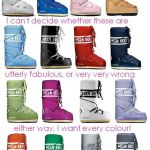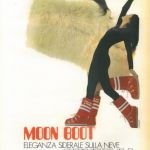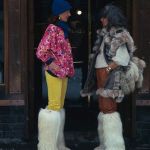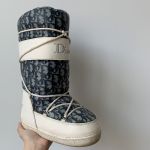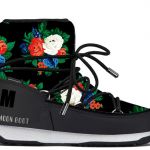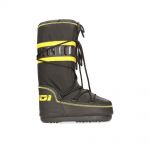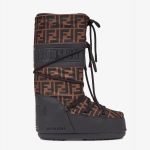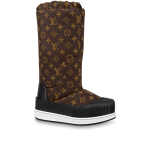
From the NASA to the àpres-ski: the history of the Moon Boot
A small step for man, a big step for footwear design
February 27th, 2021
Last January 25th, the Court of Milan issued a judgment requiring Chiara Ferragni to withdraw a boot produced by her identical brand, glitter aside, to the famous Moon Boot produced by the Tecnica group. In doing so, he reaffirmed the originality of one of the masterpieces of Italian product design of the second half of the 1900s, the Moon Boot which, starting from a factory in the province of Treviso, has come over time to be exhibited at the Louvre among the 100 symbols of 20th-century design and is today part of the permanent exhibition of the Museum of Modern Art in New York.
The design of the Moon Boot, in fact, originally created in 1969 by Giancarlo Zanatta, who founded the Tecnica group in 1960 from his father's footwear workshop, perfectly represents that historical schism with which the world of sports aesthetics has separated itself from its original context to enter the field of pure clothing, that is, lifestyle and has been imitated many times, not only by Chiara Ferragni's brand but also by brands such as Dior that has inserted a snow boot very similar to it in the FW21 collection.
Moon Boot's story says a lot about how a long-lasting and successful design should be produced. It is no coincidence that the brand appeared on the scene right after the first moon landing, indeed, Giancarlo Zanatta's precise desire to replicate Buzz Aldrin's used boots to move the first step on the Moon, seen on a billboard on the occasion of a trip to New York, captured so perfectly the zeitgeist of the time that it produced a design that has not substantially aged in over half a century. In addition to the cultural zeitgeist, Zanatta was also able to intercept the needs of a specific audience, namely mountain lovers, creating alternative footwear to the usual brown or black leather boots used until then and that were not even completely waterproof.
One of the greatest testaments of the cultural impact Moon Boot had in those years are the shots of Slim Aarons, a famous chronicler of the life of the European and American jet-set, who dedicated many series of photos to the jet-set of ski resorts such as Cortina and Gstaad in which the boots appear at the feet of the princesses of the last European aristocracy or at the feet of the guests of the Furstenberg house. The Moon Boot changed the rules: it was composed of nylon (the same fabric that In the mid-1980s Miuccia Prada would raise to luxury material), it was light, impossible to wet, ambidextrous and produced in a series of flamboyant colourways that gave a shock to the aristocratic and frigid après-ski wardrobe of the 70s. The use of synthetic materials had already been cleared in the USA by Bob Lange, but Zanatta adopted it better using double injection technology to create layers of material with different hardnesses giving life to the Tecnus boot – an operation learned by visiting Fiat factories where injection plastic moulds were used for car dashboards.
The success was great: at the first fair where they were exhibited, they sold a thousand pairs in a single day. During the 1970s and especially the 1980s boots became one of the favourite shoes not only of the Paninari of San Babila but also of Paul McCartney and his wife. In 1986 it reached the record share (by then) of one million pairs sold worldwide while already in 1993, with the acquisition of Lowa, the Tecnica group had become the leader in the outdoor footwear sector and in Chanel's FW94 collection, Karl Lagerfeld created an imitation that ended up at the Metropolitan in New York. The 90s also represent a central moment in the life of the brand, which over the years had become an icon of that retrofuturism loved in the club scenes and became such an iconic product among the younger generation that in 2004 Jared Hess put them on the protagonist of Napoleon Dynamite, one of the greatest American cult indie comedies of all time as well as a real compilation of trends and styles of those years that would find wider development in Future.
Meanwhile, various collaborative and non-collaborative versions of the Moon Boot began to appear on catwalks around the world. The brand collaborated with Fendi, Jimmy Choo, MSGM, Jeremy Scott and Moncler but Chloè, Dior, Gucci, Prada, Dolce & Gabbana and Louis Vuitton produced their own versions of the so-called snow boot or winter boot recognizable always for the silhouette, the shape of the sole and the trekking laces. The prolific nature of these imitations and collaborations has given Moon Boot the status of quintessential ski boots, whose design has surpassed the universe of a single brand and has become a type of footwear in its own right a bit as it happened to Nike's Dunks, whose overall silhouette was freely taken up by Rick Owens' Geobaskets by BAPE Sta of A BATHING APE and also by the Court Hi of Saint Laurent to name the most famous cases.
However, the brand seems to be ready to reaffirm the originality and heritage of the Moon Boot, also reporting positive data such as a 70% increase in online sales in North America, a territory on which the product has no physical retailers. At the moment there is a vast strategy that will see the brand arrive in the Asian and US markets, driven by the offer of the FW21 collection that will then expand also in the production of accessories. But the most important thing is that the repositioning on the market will take place through a fairly dense collaboration program and a relaunch of its e-commerce, as the general manager of the brand, Mirko Massignan, has hinted:
«If previously it was the brands that contacted us, from this season we decided which partners we would have liked to work with, choosing them also based on their presence in the markets in which we want to expand. We have several collaborations in the pipeline: one focused on women, one on sustainability, a unisex dedicated to our iconic models, a very pop with which we intend to reach the Asian clientele. [...] We will also adopt a more immediate type of communication inspired by the concept of see now buy now, focusing every month on a particular product».



















































